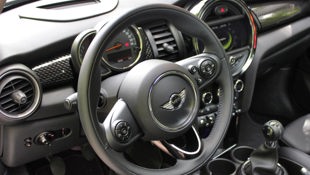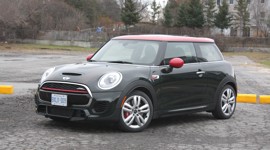Vehicle Type
Great mileage, instant recognition, amusing performance, and potent power.
Small Hatchback / Convertible
History/Description
The third-generation Mini Cooper hit the road for model year 2014 with more size, features, and technology than any of its predecessors. The latest take on the fun-focussed product lineup saw new engines, a new take on the brand’s classic styling, and a new bevy of premium equipment on offer to Canadian shoppers after a thrifty, instantly recognizable, and fun-to-drive little car.
At launch, the third-generation Mini was available in a three-door hatchback, though a five-door model with a stretched wheelbase and more interior volume soon joined it.
Other available model variants included the Mini Countryman, which crossed the Mini Copper with a small crossover, and the Mini Clubman, which was available as an up-sized take on the standard Mini. There was also a convertible.
Some units were available with all-wheel drive (dubbed ALL4), as well as various higher-performing engine and chassis configurations, typically designated by a letter “S” or a John Cooper Works (JCW) badge.
Feature content, depending on the model selected, may include active cruise control, road sign detection, advanced connectivity systems, heated leather, automatic lights, wipers and climate control, premium stereo systems, and plenty more. Additionally, a huge variety of accessories and standalone options made the Mini lineup easy to customize to any taste or budget.
Note that, depending on the year and model selected, the Mini of your fancy may be using some combination of second- and third-generation Mini platforms and technologies.
The information below is centered mainly around the three-door and convertible models, though much of it is also applicable to other recent Mini models. If in doubt, remember that a dealer Pre-Purchase Inspection (PPI) is your number-one best defence against buying a used Mini that’s concealing possible issues.
Engines
Look for an all-turbocharged engine lineup, with powerplants including a three-cylinder turbo gasoline engine with 134 horsepower, or a turbocharged four-cylinder with about 190 horsepower. Selected high-performing Mini grades got higher-output four-cylinder engine options, topping out around 230 horsepower in the top-dog JCW models.
A drive-mode selector helped drivers set their Mini’s operation up against their currently desired blend of performance or efficiency, and transmission choices included six-speed units in the driver’s choice of manual or automatic on most machines.
What Owners Like
On all factors of fun-to-driveness, uniqueness, and cheeky attitude, the Mini Cooper seemed to have impressed owners. These folks typically rave about great mileage, instant recognition, amusing performance, and potent power, especially on higher-output models. The appearance and build quality of the cabin are also, generally, highly rated. Many owners also enjoy the availability of all-wheel drive (AWD) for added traction in inclement weather.
What Owners Dislike
Depending on the model selected, some owners wish for more cargo and rear-seat space, and a smoother ride on rough surfaces. Some wish for a quieter ride, too.
Check our handy owner reviews section for the scoop on the specific Mini model you’re interested in.
Pro Tip
As it often goes with premium cars, the Mini model range seems to appeal more strongly for style, driving dynamics, and performance than low long-term running costs and overall reliability. Budget accordingly – depending on the model selected, the Mini you’re considering may require more expensive tires, brake components, fuel, suspension components, replacement filters and fluids, and lighting components than comparable compact cars. Check insurance costs before agreeing to buy as well.
Here’s Your Test Drive To-Do List
Maintenance is Mandatory
Closely following factory-prescribed maintenance is important for the long and trouble-free life of any vehicle, and according to more than one owner, that’s especially true of the Mini model range. Familiarize yourself with the maintenance schedule of the Mini you’re considering, and seek out a model with full service records indicating that no maintenance has been skipped or stretched. This includes oil changes.
Here’s a little more reading that points to some owners even choosing to change their engine oil more frequently than what’s advised in the owner’s manual, which isn’t a bad idea. In general, most Canadian drivers are best to follow the “severe” service schedule for fluid changes, and to have fluids changed at or (preferably) well before the intervals set out in that schedule for maximum peace of mind.
Extended Warranty
if the Mini you’re considering is offered with an extra-cost extended warranty, you may want to consider it, or maybe, you don’t. There are arguments for and against extended warranty coverage: on one hand, you’re likely covered for potentially pricey repairs down the line. On the other hand, skipping extended warranty coverage and banking the funds in case a repair is required means you still have money in your pocket for repairs if they’re needed, as well as if they’re not. Here’s some more reading to consider.
Also, note that some owners have had numerous problems with their Minis, and others have had none. Here’s some more reading. Further, take online reliability reports with a grain of salt, as they’re usually far too generalized and typically fail to present all relevant information.
Major Issues Uncommon
In this discussion thread, some owners discuss potential reliability issues with the third-generation Mini models thus far. The gist? Most problems reported to date are minor in nature and not experienced by a wide enough portion of owners to warrant much alarm, but the latest Mini models haven’t been without flaws.
There’s some talk of an isolated batch of bad engines on early (2014) models, which were replaced under warranty at low miles due to a faulty bearing. Noisy rear shocks on some early models from this generation were also replaced by dealers under warranty.
Check the Paint
Give the Mini’s paint-job a full inspection, calling any excessive wear, chipping, swirling, or scratching into your pricing negotiations. Be sure to carefully inspect the area where any of the rubber door seals meet up with a painted surface nearby, as some owners have reported that an abrasive texture to the rubber may cause paint wear at those locations over time. Check all decals, stripes, and badging, as equipped, for presence and condition, too.
Warnings and Sensors
If you see a warning message that reads, “Drivetrain fault, maximum power not available, contact service,” one or more driveline sensors may require some attention. This warning message has multiple potential causes. Most are minor, but some are severe. If this message appears on the used Mini you’re considering, be sure to have a dealer technician determine why, before you buy.
Central Command Unit
Plan to spend a few minutes running the Mini’s stereo and central command unit through its paces. Confirm proper operation of the screen, all nearby buttons, and playback from all media sources. Be sure to confirm that the Bluetooth connection works properly between your smartphone and the vehicle, as well. Typically, any problems on this front can be remedied with a system hard reset, or updated software installed by a dealer. Just be sure that’s the case before you buy: replacing a bad central command system in your Mini can be very pricey. Be sure to run the Mini controller, located between the front seats, through its paces to check for proper operation, too.
Check the Windows
Inspect the windows for signs of straight-line scratches, unwanted noise or hesitation upon opening or closing, or any sign that the window may be struggling to operate as expected. If any of the above issues are noted, associated power window hardware may need some attention, adjustment, and/or lubrication. Note that regular “forcing” of a window that’s frozen with ice to a weather seal or door opening can eventually cause damage, so use caution in winter months. Regular inspections, adjustment, and lubrication of window hardware can help keep things healthy for the long haul, too. Owners should also confirm that all power window switches, and door lock switches, work as expected.
Transmission Problems
Be aware of the information in this discussion thread, which outlines a recall to fix transmission problems on about 1,900 units from 2014 and 2015 model years. This recall is performed for free by dealers to prevent the vehicle from accidentally rolling away, even when the gear indicator shows that the Park position is engaged. The fix is a simple reprogramming of the transmission’s computer brain. With the VIN number of the model you’re considering, a dealer should be able to quickly determine if it qualifies for the recall.
Software Updates
Sometimes, dealers install new computer software to a vehicle to help fix or prevent a variety of issues. These may include poor performance and mileage, wonky safety systems, or even unwanted battery drain. Translation? For minimized likelihood of headaches, shoppers are advised to confirm that the Mini they’re considering has all applicable software updates installed, by talking with a Mini service advisor. You’ll need the vehicle’s VIN number.
Other Useful Checks
Modifications
Numerous tuner programs, power programmers, or “chips” are available in the automotive aftermarket to increase the power output from your new-to-you Mini’s turbocharged engine. Unfortunately, modifications like these will void your powertrain warranty, and could blow up your engine. Sound lousy? We agree. That’s why we recommend making absolutely sure the Mini you’re considering has never run non-factory engine programming. Even if set “back to stock”, dealers can detect the presence of former tuning software, and will likely void any warranty coverage accordingly.
Brakes and Clutch
Numerous factors contribute to premature brake and clutch wear, and some owners have reported shorter-than-expected life from these components. When approaching a used Mini, assume that it needs a new clutch and new brakes, until you confirm otherwise, possibly with the help of a technician.
Recalls
The Cooper name encompasses many models, so check for recalls on the specific Mini model you’re considering here.
The Verdict
For maximum peace of mind and minimal likelihood of problems and issues down the line, budget for as new a Mini model from this generation as your budget allows – and be sure that all service records are available, that all applicable recalls have been completed, and that all applicable software updates have been applied.
A model that’s been exclusively serviced by a single Mini dealer is best, as is a model sold under Mini’s certified pre-owned (CPO) program – which requires models to meet a high standard of quality, and undergo additional inspections, before being sold.
Crash Test Ratings
Check the IIHS safety rating for the specific Mini you’re considering here.
Check the NHTSA safety rating for the specific Mini you’re considering here.







































